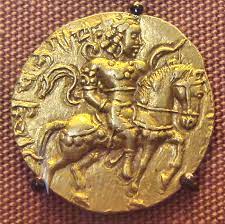Chandragupta II, also known as Chandragupta Vikramaditya, was a powerful emperor of the Gupta Empire in India. He ruled from 375-415 CE, and his reign is considered the Golden Age of the Gupta Dynasty. In this article, we will explore the life, achievements, and legacy of Chandragupta II.

Table of Contents
Early Life of Chandragupta II
Chandragupta II was born to Samudragupta, the second emperor of the Gupta Dynasty, and his queen, Dattadevi. He was the eldest son and was groomed to be the next king. When Samudragupta died in 375 CE, Chandragupta II ascended the throne at the age of 20. He faced many challenges at the beginning of his reign, including the invasion of the Huna tribe and rebellion in the western regions of his kingdom. However, he was able to defeat these challenges and establish his authority over the entire empire.
Military Achievements of Chandragupta II
Chandragupta II was a great military strategist and expanded the boundaries of his empire. He defeated the Shaka rulers of western India and extended his rule up to the Arabian Sea. He also defeated the Kalinga rulers of eastern India and brought their territory under his control. His most famous military achievement was the defeat of the Saka Western Kshatrapas. The Saka rulers were a powerful group that had ruled western India for over 400 years. Chandragupta II defeated them in a series of battles and forced them to submit to his rule. This victory brought immense wealth and resources to his empire.
Patronage of Arts and Learning
Chandragupta II was a great patron of the arts and learning. He supported scholars, artists, and poets, and his court was a center of culture and learning. He was particularly interested in astronomy and invited the famous astronomer, Aryabhata, to his court. Under his patronage, Aryabhata wrote his famous book, Aryabhatiya, which contains many important discoveries and theories in astronomy and mathematics.
Religious Tolerance
Chandragupta II was a religiously tolerant ruler and did not discriminate on the basis of religion. He patronized all religions and built temples and monasteries for Hindus, Buddhists, and Jains. He was a devout Hindu and is said to have performed many yajnas (sacrificial rituals) during his reign. However, he also respected other religions and did not impose his beliefs on his subjects.
Legacy
Chandragupta II’s reign is considered the Golden Age of the Gupta Dynasty. He was a powerful and efficient ruler who expanded the boundaries of his empire and brought wealth and prosperity to his people. His patronage of the arts and learning led to a great flourishing of culture and scholarship. His religious tolerance and respect for all religions set an example for future rulers in India.
Conclusion
He was a great ruler who left a lasting legacy on India. His military achievements, patronage of the arts and learning, and religious tolerance continue to inspire people even today. He is remembered as one of the greatest emperors in Indian history, and his reign remains a shining example of a just and efficient administration.
Important Links